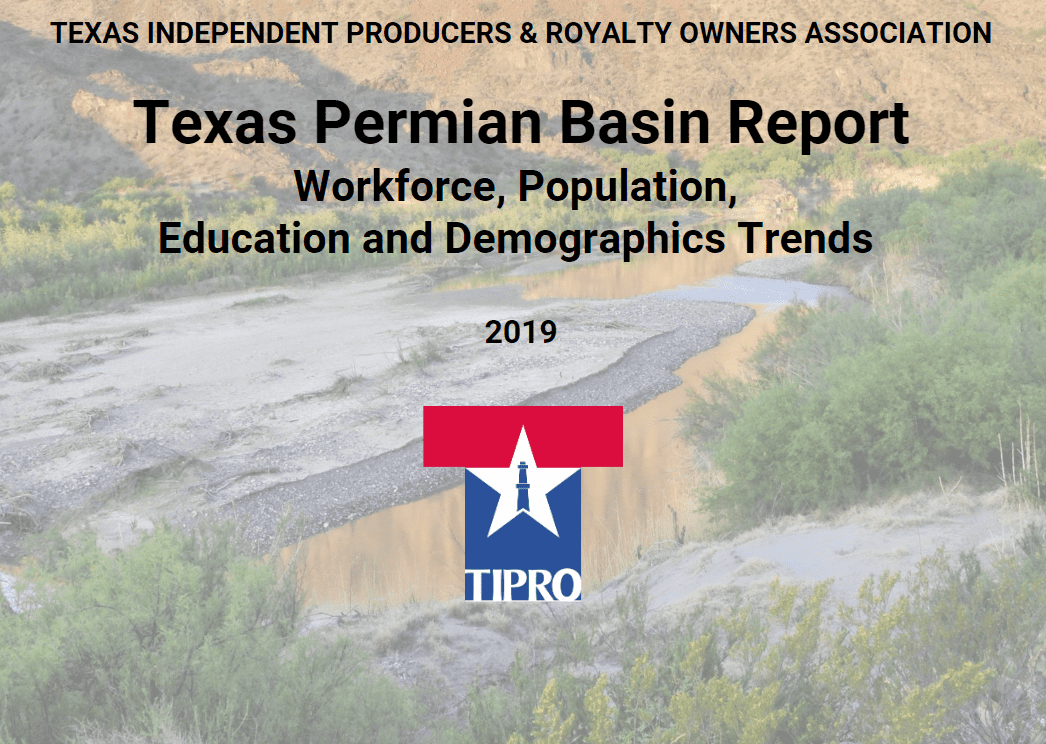Austin, Texas – While energy development in the Permian Basin continues to skyrocket, a new report by the Texas Independent Producers & Royalty Owners Association (TIPRO) takes a closer look at population, education, workforce, and demographic trends across multiple business sectors in the oil-and-gas rich region that spans across West Texas. In the past five years, communities situated in the heart of the Permian have experienced tremendous growth in population, as drilling in the nearby oil patch draws in new workers. TIPRO estimates that the overall residential population in the Permian grew approximately 3.3 percent between 2013-2018. Industries related to the energy sector – including oil and gas extraction, pipeline transportation and other support activities for mining – offer some of the strongest employment rates for those living in the Permian, though other industries like health care, retail services and construction also provide substantial levels of employment to residents in the area, TIPRO’s report also shows.
“Today, the Permian Basin is one of the world’s top oil-producing regions. In just the past five years, oil output in the region has more than doubled. The growth of the oil and natural gas industry brings enormous opportunity and benefit to the Permian Basin, but that growth can also put a strain on infrastructure, education, health care and other areas essential to supporting the region and state across all industry sectors,” said TIPRO President Ed Longanecker. “Unique challenges also arise during a market downturn, something West Texans know all too well. Monitoring trends in the Permian Basin region is important in understanding the market factors that impact the economy and our fellow Texas citizens, as well as to further quantify the importance and influence of the oil and natural gas industry for our state and country.”
TIPRO’s new analysis also shares insights on the education pipeline coming out of this vast portion of the state. The next generation of graduates from the Permian will hold an important role in serving the workforce needs that allow Texas to fully capitalize on the opportunities presented in the Basin. In 2017, there were approximately 34,555 graduates in the Texas Permian Basin region. This number has grown by 2 percent over the last five years. The highest share of these graduates came from the following disciplines: Liberal Arts and Sciences/Liberal Studies, Registered Nursing/Registered Nurse, and Medical/Clinical Assistant.
Other highlights from TIPRO’s Permian Report include:
- In 2018, total population in the Texas Permian Basin region totaled 2,061,422. Regional population grew 3.3 percent over the last five years, with the addition of 65,942 new residents, and is projected to expand another 2.3 percent by adding 47,000 people by 2023.
- The region had 477,378 millennial (ages 20-34) residents last year.
- The top three industries in 2018 in the area were Education and Hospitals (Local Government), Restaurants and Other Eating Places, and Support Activities for Oil & Natural Gas.
- From 2013 to 2018, jobs increased by 7.1 percent in the Texas Permian Basin from 902,908 to 966,657. As the number of jobs has gone up, the labor force participation rate increased from 59.3 percent to 59.4 percent between 2013 and 2018.
- The Texas Permian Basin oil and natural gas industry has a jobs multiplier of 10.6 percent. The earnings multiplier for oil and gas in the region is 3.3 percent, and sales multiplier is 1.6 percent.
- In 2018, the Texas Permian Basin oil and natural gas industry purchased U.S. goods and services in the amount of $20 billion from 974 business sectors, 45 percent of which came from within the region.
- Midland County has the highest percentage of occupied housing units (93.2 percent), followed by Ector County (90.3 percent ), El Paso County (90.8 percent), Tom Green County (89.8 percent), Crane County (88.6 percent) and Gaines County (89.1 percent).
Download TIPRO’s ‘2019 Permian Basin Report’ by visiting http://bit.ly/TIPRO2019PermianReport.
TIPRO produces regular reports analyzing priority policy and economic issues facing independent oil and gas producers and royalty owners. The association combines decades of industry experience with data and analysis to educate the general public, industry and elected officials on the unprecedented economic contributions of the E&P sector at the local, state and federal levels. Key areas of focus include: education of operations, workforce development, industry employment and wages, innovations and technological advancements and energy policies. For additional information on the oil and gas industry, including employment figures and other oil and gas insights, be sure to also review TIPRO’s other reports at www.tipro.org.
About TIPRO
The Texas Independent Producers & Royalty Owners Association (TIPRO) is a trade association representing the interests of nearly 3,000 independent oil and natural gas producers and royalty owners throughout Texas. As one of the nation’s largest statewide associations representing both independent producers and royalty owners, members include small businesses, the largest, publicly-traded independent producers, and mineral owners, estates, and trusts.





